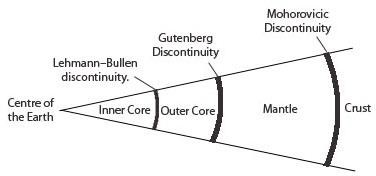Fig 7: Earth Crust
Its thickness is about 2900 Km. It volume is 83% of the whole earth. Near the lower limit of the crust the velocity of P-waves increases from about 6.4 kilometers per second to 8 km per second. This change in velocity of P-waves indicates the surface discontinuity between the crust and the mantle. It is popularly known as Moho or the Mohorovicic discontinuity (after the name of its discoverer).
The mantle is made up of dense and heavy materials such as oxygen, iron and magnesium. The average density of the materials in the mantle varies between 3.5 g per cubic cm and 5.5 g per cubic cm. The temperature of this layer ranges between 900°C and 2200° C. The temperature is quite high and the hot rocks form magma in this layer. The pressure of the overlying layers, keeps the lower part of the crust and the upper part of the mantle in an almost solid state. If cracks appear in the crust, the pressure is released and the molten matter from inside the Earth tries to reach the surface through volcanic eruptions.
The upper portion of the mantle is called asthenosphere. The word astheno means weak. It is considered to be extending upto 400 km. It is the main source of magma that finds its way to the surface during volcanic eruptions.
The mantle plays an important role in all the happenings in the interior of the earth. It also gives rise to Convection Currents. These currents supply energy for happenings like continental drift, earthquake, volcanoes, etc.

